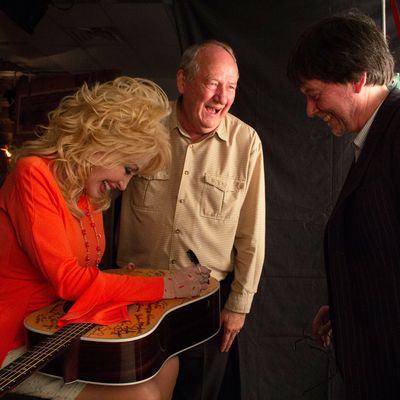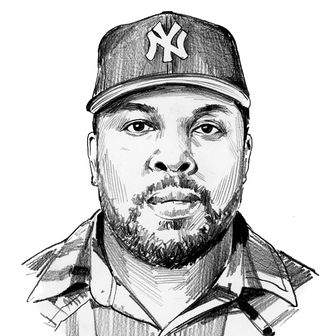
The story of country music is the story of America, of a young nation settling into the technologies that would come to define it, and the ups and downs of the people making a living there in the thick of it. The music trickled down from mountain folk carrying culture from their ancestral lands into the vast expanse of the new country. It rose up like a prayer from the slaves of the field tarrying thanklessly in a political system that traded them like chattel. It jolted cross-country on the backs of trains and took root in cities, where it nurtured business and flowed deeper into the country via radio towers. It told stories that hadn’t been heard; it gave voice to the voiceless. In 16 painstaking hours, Ken Burns: Country Music traces the trek from old-time fiddlers and intrepid songcatchers to motion pictures and arena tours. What emerges is a history of American ingenuity, of enterprising thinkers paving ways where they hadn’t yet existed.
Country Music’s early hours are a dance between advances in tech and developments in culture. AM-radio stations sprouted across the country, providing hardworking families with a bit of respite from the souring economic prospects of the ’30s. You begin to meet characters like Victor Talking Machine Company talent scout Ralph Peer and Atlanta-area performer Fiddlin’ John Carson, who teamed up for the first commercial country recording. You revisit the fateful August 1927 sessions where Peer recorded the Mississippi yodeler Jimmie Rodgers and the husband, wife, and sister act that would come to be known as country music’s first family, the Carters. Rodgers sang of hustlers and gamblers in tunes like “Blue Yodel No. 9 (Standin’ on the Corner)” and “In the Jailhouse Now”; the Carters addressed matters of the heart and spirit in “The Church in the Wildwood” and “The Storms Are on the Ocean.”
Burns illustrates a duality here that sticks for the remainder of the film, a tug-of-war between Saturday night and Sunday morning, between barstool and church pew. The push and pull between Rodgers’s rough living and the Carters’s Christian sensibilities are mirrored later on in the music of Hank Williams, the hard-drinking Alabama “Hillbilly Shakespeare” who devised an alter ego, Luke the Drifter, to sing gospel numbers like “I Saw the Light,” and in Johnny Cash, the Carter-family scion through marriage who sang hymns and also performed in prisons, having had experiences of both as he bounced from amphetamine dependency to redemption. Cash is Burns’s through line from the Carter family to Sun Records’ rockabilly hits of the ’50s, dalliances with folk and rock in the late ’60s, and the emergence of Americana in the ’80s and ’90s. He brings Elvis and Bob Dylan into the fold early on and inspires a love of the classic country songbook in his daughter, Rosanne, who added her own twist in the ’80s and beyond.
Along the way, Country Music tells the story of the invention of the music business as we now know it, and the innovations and oversights that came with it. Restless sons and daughters of farmers, oil-rig workers, and brakemen learned how to package and sell their pain, and enterprising businesspeople were born. Singing cowboys like Gene Autry made a mint on motion pictures and promotional products carrying their names. (The most lurid side hustle is Louisiana singer Webb Pierce’s stint selling dollar Mason jars of water from the guitar-shaped swimming pool at his Nashville home, which fans also paid money to visit.) Radio stations developed barn-dance shows to open up live events and break talented performers to larger audiences as clear-channel stations began to broadcast signals from coast to coast.
These developments dovetailed in the birth of the Grand Ole Opry, a weekly variety show transmitted out of Nashville’s Ryman Auditorium, the “Mother Church of Country Music.” The Opry was, and is, a strong defender of country music and culture and a potentially forbidding venue for artists too far left of the dial. The Opry boosted the careers of legends like Bill Monroe and Roy Acuff, but its partiality toward clean-cut, wholesome talent made it hesitant to invite Hank Williams at his peak, resistant to Elvis’s rock-and-roll revolution, and obstinate in the face of ’60s advances in country-rock. The disastrous response to the Byrds in their first and only Opry gig (which telegraphed radio’s rejection of the band’s 1968 classic Sweetheart of the Rodeo) sticks out among missed opportunities for the organization to adapt to the times.
Country Music uses the Opry to strike a balance between purity and progression and also to dramatize the public’s jibing tastes in artifice and authenticity. The great Tennessee humorist Minnie Pearl was a college grad doing respectful satire of southern culture in the same way that performers from the Dust Bowl days to the Hee Haw era used fashion to appeal to working-class audiences. People craved realism, but they wanted showmanship too. (This is how we get big hair and Nudie suits, how folksy acoustic performances evolve into shiny stadium spectacles.) Strike the right balance between the two and the audience might love you forever. Deviate from the script and you were on your own. A poignant example of great risks and edifying rewards from the later stretches of the doc is Columbia’s initial reluctance to put out Willie Nelson’s 1975 high-water mark Red Headed Stranger because suits thought it unfinished. Talent won for Willie; the label released Stranger to appease him and was surprised by its critical and commercial success. But many country artists suffered for differing from the norm.
The documentary’s musings on race and gender examine the shortcomings of conservatism as a tentpole in the arts. Many of the great white male singer-songwriters through country history cop to having been inspired by black performers, who could never enjoy the same shine. Mississippi singer-songwriter and mandolin whiz Marty Stuart states it eloquently: “If you took Mr. Lesley Riddle out of the A. P. Carter equation as a songcatcher and a song gatherer, if you took Arnold Shultz out of Bill Monroe’s life, or if you took [Rufus] ‘Tee Tot’ [Payne] out of Hank Williams’s life, just those three alone, look how differently it would turn out.” Texas country-and-folk genius Townes Van Zandt caught the spark listening to Lightnin’ Hopkins. Johnny Cash’s muse was bluesman Gus Cannon. Contrast this adoration across lines of race with the story of DeFord Bailey, the black harmonica and guitar player whose performing career ended when he was ousted unceremoniously from the Opry in 1941, or the stunned silence at the sight of the first public Charley Pride gig, in which people had to confront the reality that the voice on some of their favorite songs belonged to a black man. A report from Hank Williams’s funeral mentioning 200 black fans in the segregated seats is the rare acknowledgment of the true diversity of the listening audience.
Country Music explores women’s struggles too, but it treads very lightly. Sarah and A. P. Carter’s keeping their split a secret for years is understood to have been a career necessity. The flap over Loretta Lynn’s feminist anthem “The Pill,” which became a hit in spite of label delays and radio bans, is seen in the context of an industry still working its way up to the idea of women in positions of power. In these areas, Country Music lets the viewer draw the obvious conclusions. It’s honest but never judgmental. It prefers to celebrate the strength of the network of southern mothers who steered the ship than to take down the men limiting their career prospects. To that end, Burns lionizes characters like Mother Maybelle Carter, country-guitar innovator and adviser to anyone who needed a talking-to over a good meal, and Lillie Williams, mother of Hank, who is remembered as a reliable partner in a barroom brawl. Country isn’t the most provocative of Burns’s recent work; a year after the prescient vision of war and civil unrest painted in 2017’s The Vietnam War, this gallery of poets, loners, and businessmen feels romantic in comparison.
You can’t tell the story of the roots music issuing out of Nashville, Texas, California, Kentucky, and parts beyond without romance and characters, though. Country Music is perhaps best enjoyed as a stream of singers and songwriters extolling the virtues of the craft. The cast of characters is astounding — it’s full of voices you wouldn’t expect to hear, like the late Merle Haggard. There’s brilliant industry women, like the singer Brenda Lee, or the writer Hazel Smith, who first coined the term “outlaw country.” Marty Stuart lends Burns his encyclopedic knowledge of music history and his lightning-fast fretwork (and, in an upset, edges Dolly out for best hair and wardrobe with his gothic threads and silver mane). The lifers are a riot. Western swing singer Ray Benson of Asleep at the Wheel captures the spirit of the Austin scene of the ’70s in a single sentence: “Rent was $100, and pot was cheap.” Neo-traditionalist songwriting hawks like Vince Gill and Dwight Yoakam work hard to find words to describe their love of a song or turn of phrase.
Ken Burns: Country Music carries something for fans at every level of their journey with country and western music. If you’re new to the stuff, you get an exhaustive primer on all of the tributaries flowing into and out of the culture. If you’re the type who only digs the outlaw era, stick it out for the ’50s, ’60s, and ’70s sections, and lively origin stories like the account of the inquisitive Columbia Studios janitor who turned out to be Kris Kristofferson. If you’re up on all the pertinent historical developments, you get to see legends gush over each other’s achievements and enjoy interviews with a number of figureheads who’ve passed on in the last five years. The greatest compliment you could pay an undertaking like this is to wish there were more of it. One wonders what Burns would make of cowpunk and alt-country or southern rock or progressive bluegrass, styles that Country Music glosses over in favor of extensive profiles of titans and kingmakers. It’s gratifying, illuminating television regardless.





